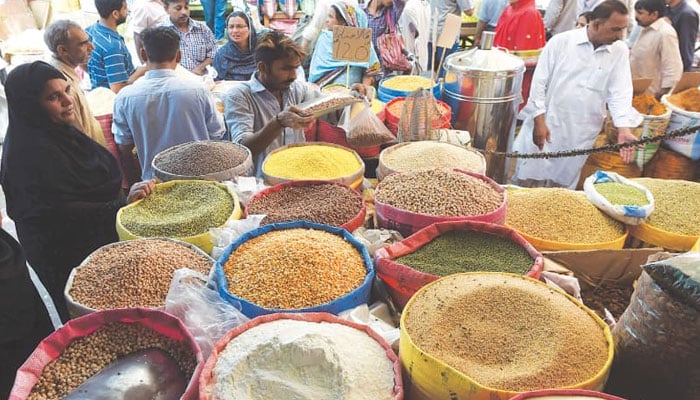Food inflation hits rain-weary Pakistanis hard
Weekly inflation rose 3.35 percent week-on-week and 42.31 percent year-on-year, over a decade high, dashing hopes of the masses about achieving financial stability in the near-term
KARACHI: Driven by higher food, petrol and electricity prices, weekly inflation rose 3.35 percent week-on-week and 42.31 percent year-on-year, over a decade high, dashing hopes of the masses about achieving financial stability in the near-term.
Data issued by the Pakistan Bureau of Statistics (PBS) on Friday said increase in the sensitive price indicator (SPI) was mainly because of spike in prices of tomato (20.28 percent), chicken (7.57 percent), electricity for q1 (6.83 percent), petrol (2.96 percent), onion (2.30 percent), powdered milk (2.03 percent), cigarette (1.69 percent), eggs (1.63 percent), pulse moong (1.42 percent) and potatoes (1.07 percent).
The massive increase of 42.31 percent in annualised SPI was slammed by the opposition. Muzammil Aslam, PTI spokesperson on economy and finance, tweeted that SPI crossed 40 percent for the first time in Pakistan’s history. Last week, according to the Bureau of Statistics, Pakistanis saw 42.31 percent increase in inflation compared to the same period last year, he added.
SPI comprises 51 essential items collected from 50 markets in 17 cities of the country. During the week, out of 51 items, prices of 25 (49.01 percent) items increased, 11 (21.57 percent) items decreased, and 15 (29.42 percent) items remained stable.
Fahad Rauf, head of research at Ismail Iqbal Securities, said the SPI jumped by 3.35 percent WoW mainly because of increase in electricity, petrol, tomato and chicken prices during the week.
Electricity price adjustments would likely continue due to planned base tariff hikes and expected higher fuel price adjustments. “We expect inflation to peak in August 2022 around 27 percent due to low base effect and energy price adjustment,” he added.
With broad rises in prices across the country, further fuelled by the devastating rains in lower Punjab, Balochistan, and Sindh, inflation rate has been accelerating at a greater pace, highlighting the difficulties faced by the coalition government in controlling this menace. Inflation was one of the reasons former prime minister Imran Khan had to face a vote of no-confidence.
Shaukat Tarin, former federal minister for finance and revenue, said, “This government came to reduce inflation. In end March, SPI was 17 percent and now it has exceeded 42 percent. The people of Pakistan are paying a very heavy price for this experiment which has gone wrong.”
Topine Securities in its note said the increase in SPI was “over a decade high”. The massive increase in SPI has impacted all expenditure groups; divided in five quintiles by the PBS. For the groups spending up to Rs17,732; Rs17,733-22,888; Rs22,889-29,517; Rs29,518-44,175; and above Rs44,175; YoY SPI increased 34.24, 40.43, 39.37, 39.54, and 43.30 percent, respectively. On WoW basis, the change for the groups was 1.8, 2.25, 3.03, 3.19, and 3.94 percent, respectively.
Different weightages are assigned to various commodities in the SPI basket. Commodities with the highest weights for the lowest quintile include milk (17.5449 percent), electricity (8.3627 percent), wheat flour (6.1372 percent), sugar (5.1148 percent), firewood (5.0183 percent), long cloth (4.2221 percent), and vegetable ghee (3.2833 percent).
Of these commodities, prices of electricity, wheat flour and long cloth increased, while the prices of sugar, firewood, vegetable ghee and unpackaged milk declined. However, the prices of all commodities spiked higher on YoY basis except for refined sugar, which shed 16.55 percent.
-
 Ben Affleck Doesn't Want His Kids To Join Showbiz: Here's Why
Ben Affleck Doesn't Want His Kids To Join Showbiz: Here's Why -
 George R.R. Martin Calls 'House Of The Dragon' S3 'not My Story'
George R.R. Martin Calls 'House Of The Dragon' S3 'not My Story' -
 Kim Kardashian Gushes Over 'baby Girl' Chicago As She Turns 8
Kim Kardashian Gushes Over 'baby Girl' Chicago As She Turns 8 -
 Drew Barrymore Reflects Heartbreaking Body Shaming She Faced At Just 10
Drew Barrymore Reflects Heartbreaking Body Shaming She Faced At Just 10 -
 Pamela Anderson Felt 'weird' Seeing Seth Rogen After 'Pam & Tommy'
Pamela Anderson Felt 'weird' Seeing Seth Rogen After 'Pam & Tommy' -
 Kelly Clarkson Discovers A Shark Named In Her Honour
Kelly Clarkson Discovers A Shark Named In Her Honour -
 HBO Mulls Major 'Game Of Thrones' Spin-off Focusing On A Stark
HBO Mulls Major 'Game Of Thrones' Spin-off Focusing On A Stark -
 Ashton Kutcher Says He's Proud Of Demi Moore
Ashton Kutcher Says He's Proud Of Demi Moore -
 Why Prince William, Kate Hired A Crisis Expert Despite Royal 'calm'?
Why Prince William, Kate Hired A Crisis Expert Despite Royal 'calm'? -
 Extent Of Meghan Markle’s Fears Gets The Spotlight: ‘The Press Detest Her Which Is A Problem’
Extent Of Meghan Markle’s Fears Gets The Spotlight: ‘The Press Detest Her Which Is A Problem’ -
 Caitlyn Jenner Finally Reacts To Kylie, Timothee Chalamet Relationship
Caitlyn Jenner Finally Reacts To Kylie, Timothee Chalamet Relationship -
 Prince William’s Beefed Up PR All Set To Fight Off ‘plot’ And ‘it Might Not Be Long’
Prince William’s Beefed Up PR All Set To Fight Off ‘plot’ And ‘it Might Not Be Long’ -
 Kate Middleton Ups A New Role Unofficially For King Charles As William Prepares His Coronation
Kate Middleton Ups A New Role Unofficially For King Charles As William Prepares His Coronation -
 Teyana Taylor Says She Misread Leonardo DiCaprio Globes Moment
Teyana Taylor Says She Misread Leonardo DiCaprio Globes Moment -
 A$AP Rocky Reveals What Encouraged Him To Date Rihanna
A$AP Rocky Reveals What Encouraged Him To Date Rihanna -
 Newborns At Risk: Health Experts Warn Your Baby Could Already Have Diabetes
Newborns At Risk: Health Experts Warn Your Baby Could Already Have Diabetes




